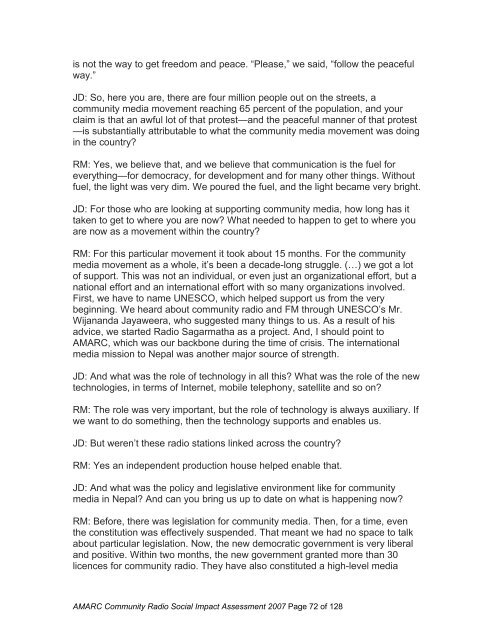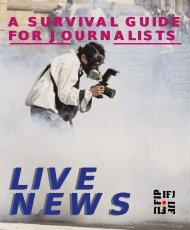Removing Barriers, Increasing Effectiveness - amarc
Removing Barriers, Increasing Effectiveness - amarc
Removing Barriers, Increasing Effectiveness - amarc
You also want an ePaper? Increase the reach of your titles
YUMPU automatically turns print PDFs into web optimized ePapers that Google loves.
is not the way to get freedom and peace. “Please,” we said, “follow the peacefulway.”JD: So, here you are, there are four million people out on the streets, acommunity media movement reaching 65 percent of the population, and yourclaim is that an awful lot of that protest—and the peaceful manner of that protest—is substantially attributable to what the community media movement was doingin the country?RM: Yes, we believe that, and we believe that communication is the fuel foreverything—for democracy, for development and for many other things. Withoutfuel, the light was very dim. We poured the fuel, and the light became very bright.JD: For those who are looking at supporting community media, how long has ittaken to get to where you are now? What needed to happen to get to where youare now as a movement within the country?RM: For this particular movement it took about 15 months. For the communitymedia movement as a whole, it’s been a decade-long struggle. (…) we got a lotof support. This was not an individual, or even just an organizational effort, but anational effort and an international effort with so many organizations involved.First, we have to name UNESCO, which helped support us from the verybeginning. We heard about community radio and FM through UNESCO’s Mr.Wijananda Jayaweera, who suggested many things to us. As a result of hisadvice, we started Radio Sagarmatha as a project. And, I should point toAMARC, which was our backbone during the time of crisis. The internationalmedia mission to Nepal was another major source of strength.JD: And what was the role of technology in all this? What was the role of the newtechnologies, in terms of Internet, mobile telephony, satellite and so on?RM: The role was very important, but the role of technology is always auxiliary. Ifwe want to do something, then the technology supports and enables us.JD: But weren’t these radio stations linked across the country?RM: Yes an independent production house helped enable that.JD: And what was the policy and legislative environment like for communitymedia in Nepal? And can you bring us up to date on what is happening now?RM: Before, there was legislation for community media. Then, for a time, eventhe constitution was effectively suspended. That meant we had no space to talkabout particular legislation. Now, the new democratic government is very liberaland positive. Within two months, the new government granted more than 30licences for community radio. They have also constituted a high-level mediaAMARC Community Radio Social Impact Assessment 2007 Page 72 of 128
















